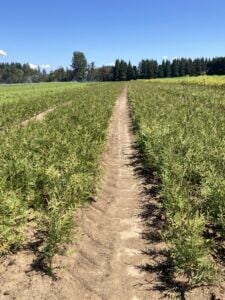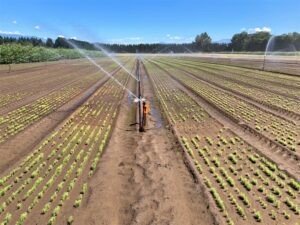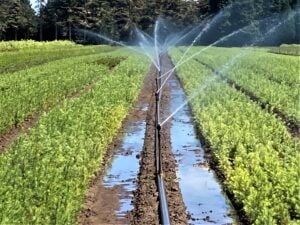PMC Update for August 3, 2023
Here are 5 things that you should know about the PMC for August 3, 2023.
June 2023 Financials
There has not been a PMC update since June due to the focus on production and propagation so it is time to catch up. One important item to report on since the last update is the June financial reports. The June report is particularly important since it is the last month of the fiscal year and therefore shows how the business has done during the past year.
Total operating revenues for the PMC for the end of June and fiscal year 2022-23 were $1,816,149. That exceeds the amount of revenue budgeted for the year by 23% and eclipses last years record setting revenue amount of $1,636,683 by $179,466. As usual, PMC Plant Sales made up most of the revenue with $1,608,144 which exceeded last years record amount of $1,431,648 by $174,496.
Of course, an increase in sales results in increased expenses. Total expenses for the PMC for FY 2022-23 were $1,537,774 which were up from the previous years’ total expenses of $1,337,236 by $200,538. Inflation was one cause for the increase as seen in the cost of staff wages, seasonal labor, packaging supplies and seeds. Inflation does not account for the total increase in seeds and packaging expenses however. Deposits on seeds for FY 2023-24 usually are not made until that fiscal year, as well as purchasing packaging. It was decided to post those expenses before the end of the fiscal year to decrease the income tax liability the PMC was looking at for income in FY 2022-23. That tax liability is another big reason why expenses were up so much since the accountant recommended that the association prepay taxes for the year. That amounted to a $70,575 expense posted on the PMC Income Statement as Federal Income Tax Expense and was not expensed the previous year.
The bottom line is that the PMC posted a net revenue for fiscal year 2022-23 of $278,375. All in all, it was a good year for the PMC. More money was earned than spent and a lot of conservation plants went to their forever homes to take on their important job of improving our environment. None of this would have been possible without broad support from the association through the years, as well as others in the conservation and restoration community throughout the Pacific Northwest, and the hard work and dedication of PMC staff. Thanks to all!
Sales

As mentioned above, fiscal year 2022-23 has been a good year for the PMC. Nowhere is that more evident than in last years’ sales statistics. Total Plant Sales for the year were $1,721,630. That includes PMC Plants, Brokered Plants, Contract Growing and Gravel Bed Plants. Out of that total, $443,642 were sales to Conservation Districts which were 26%. Sales to other customers were $1,277,988 or 74%. The total number of plants sold were 1,840,218 out of 1,868,280 harvested, which might be the best part of the year. Only 28,000 plants never found their forever home, but 98.5 % did! That is something given that over 90% of production is speculative, planning for which begins at least 2 to 3 years in advance.
Sales for fiscal year 2023-24 began this year where last years left off. At a record pace. As of July 31st, the PMC has booked $743,953 in sales for the upcoming year. That is 44% of the projected sales budget for the year. Sales to conservation districts at $344,826 are almost on pace with sales to non-districts at $399,127. That is because that at the start of the fiscal year the PMC fills CD orders first, then the others as the are received. With most CD sales posted the PMC begins taking orders as they are received with the goal of selling as many plants as possible.
Operations

As mentioned above, the PMC has been busy recently with production and propagation. Naturally irrigation has been constant and proceeding normally. As the stock begins to attain the desired size the irrigation is decreased to try to induce dormancy before any potentially damaging winter freezes arrive. Fall rains can negate these efforts but one must try. Other activities included root pruning, disease and pest management, and weed control. Everything is progressing normally except for weed control which is ahead of schedule. It is so far ahead of schedule that the weeding crew has been laid off due to lack of weeds!
On the propagation front it is seed collection time. Most of the seeds used at the PMC are collected by contract seed collectors but the PMC does more and more of its own collections. Most of those seeds come from seed collection blocks of plants being grown here. Some of these collections include Red Flowering Currant, Red Osier Dogwood, Goldene Currant, Serviceberry, Twinberry, Salmonberry, Thimbleberry, Baldhip Rose, Woods Rose and Black Hawthorn to name a few. Once collected the PMC processes the seed to extract them from their berries, hips, or capsules, remove the chaff and pulp, ending up with clean seed. So far so good for most species. The contract collectors have begun shipping completed collections. Quantities for most are as requested with a few shortages which is typical.
The one disappointing part of seed collection is once again is conifers. It looks like there will not be many cone collections for Douglas Fir, Grand Fir, Western Red Cedar, Ponderosa Pine, and Western Larch in the region. The PMC has seed in storage to cover most of these short falls and has been adding to that quantity by purchasing stored seeds from others. As a result, the PMC might exceed the expense budget for seeds for this year but that is prudent out of concern of ongoing negative effects on cone production due to climate change.
Tree Seed Summit

Jim attended the Tree Seed Summit in June held at the UW Pack Forest near Eatonville. The summit was organized by the Society for Ecological Restoration and Mast Reforestation and was aimed at addressing potential shortages in tree seeds due to less reliable cone crops and increased demand for tree seedlings. Topics included bridging the gap between current capacity and anticipated demand, staging cone collections, managing for cone and seed pests, assisted migration to better adapt for climate change, managing seed inventories and best of all, tree climbing demonstrations. The cones on conifers open and disperse their seeds while the cone is still on the tree. By the time a cone falls to the ground its seeds are already gone. In order to get conifer seeds, one must go up into the tree and collect the cones at the appropriate time, cut the tree down and collect the cones from the ground or find cone caches that the squirrels have hidden. The people who climb trees are an interesting, hard-working bunch who take their jobs seriously with safety being of utmost importance. In the end there was consensus that seed shortages are a very real concern with some aspects that are hard to determine at this time. There is not much one can do about fewer good cone crops other than to try to collect large quantities when they can. Better defining what demand will look like will require silviculturists and restorationists to provide annual seedling requirements including species and quantities a few years in advance.
Coming Attractions
Growing plants will be the primary activity at the PMC for the next 2 or 3 months, along with collecting the seeds needed to make that happen again next year. Along the way staff will take some vacation time off as schedules allow. It is assumed that at some point the weeding crew will need to return to keep up on weed control but they have done such a good job of cleaning the place up that it is unknown when that might be. Being almost weed free is terra incognito around here. As fall approaches ground will be prepared for fall seed planting. Later in the fall the live stake harvest will begin which can start a couple of months before lifting bare root plants can start. There is always something going on here 52 weeks a year.
I hope this helps. Please let me know if you have any questions. Thanks
Jim Brown, Director of Nursery Operations
